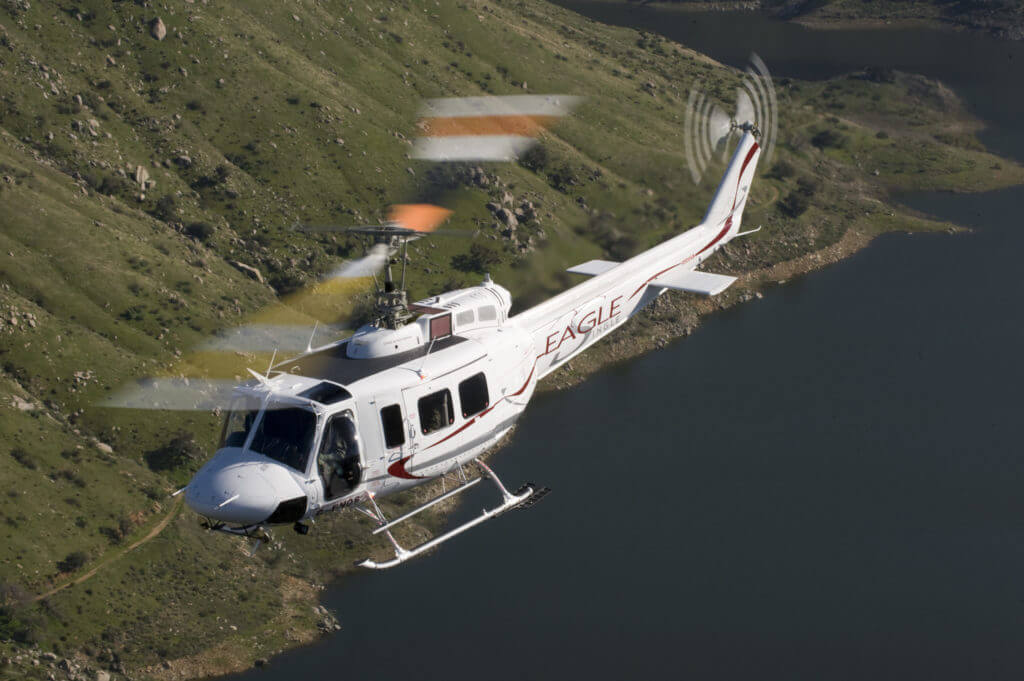Eagle Copters has gained certification of new performance charts for the Eagle Single that it says provide the single-engine aircraft with the same performance as other single- or twin-engine legacy Bell mediums.

The most substantial impact can be seen in the aircraft’s hover out of ground effect at takeoff power. Here, the Eagle Single — a single-engine Bell 212 powered by a Honeywell T53-17A or B — gains nearly 400 pounds in allowable gross weight at 20 C/7,000 feet pressure altitude (from 9,600 pounds to 9,950 pounds).
“This is where most of our concentration fell and where we had the most gain,” Spyke Whiting, Eagle’s vice president of technical sales, told Vertical. “The goal with the efforts was to get performance charts on par with other Bell medium platforms, which is exactly what we did.”
Barry Kohler, Eagle’s president and CEO, said the Federal Aviation Administration and Transport Canada had originally certified the Eagle Single conversion with “initially conservative” performance charts, but the performance enhancement certification process has allowed the aircraft to fully prove its capabilities on paper.
“Three years ago, we realized that because of the [Eagle Single’s] certification path, we were at a competitive disadvantage, and so we decided to invest the money in flying the aircraft in Leadville [Colorado] and Peru to verify the performance was what we thought it would be,” he said. “We also had to make sure that the data body was sufficient enough to put it into an STC in the form of a flight manual supplement.”
To operate at the levels stipulated in the new performance charts, operators need to install the BLR Aerospace FastFin and Strake kit, as well as use the flight manual supplement.
“One of our customers in Indonesia operates between 10,000 and 14,000 feet, and he’s been itching to get this upgrade,” said Craig Swayne, manager of sales and support at Eagle Australasia. “And we have customers operating in Cuzco, Peru, and that airport is at 12,000 feet. Between the operators in those two countries, it became evident we needed a little change.”
First certified by Transport Canada in 2010, there are now 13 Eagle Singles in operation around the world, around half of which already have the FastFin and Strake kits installed. For those that don’t, Eagle is working with BLR on securing “commercially favorable pricing” for retrofits.
Kohler said he hoped the enhancement would drive further demand for the type. “I easily see us doing one or two a year now for the short term future as a result of this,” he said. “We’ll probably even build one on spec within the next 12 months.”
In terms of regional growth, Eagle is working with potential customers in Europe and China to put the Eagle Single — and the Eagle 407HP — in those jurisdictions. Kohler said the 407HP, in which the Bell 407’s existing Rolls-Royce 250-C47B engine is replaced with a 1,021-horsepower Honeywell HTS900-2, is “absolutely perfect” for the Chinese market.
“It’s a developing aviation infrastructure and there are a lot of people operating at 3,000 to 4,000 meters,” he said. “We are specifically building a 407HP to put in China to do flight test demonstrations, and our plan is that somebody is going to buy it when they see what it does. And more people are going to want it, because in those conditions, it absolutely smokes a 407 or a AS350 B3e [H125].”









